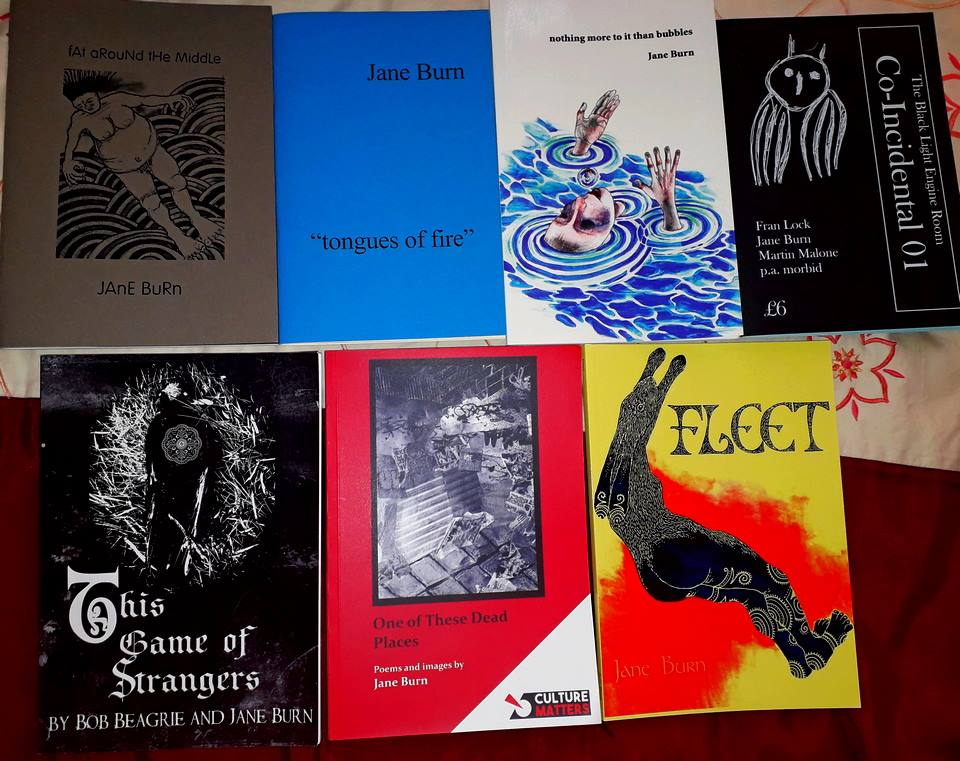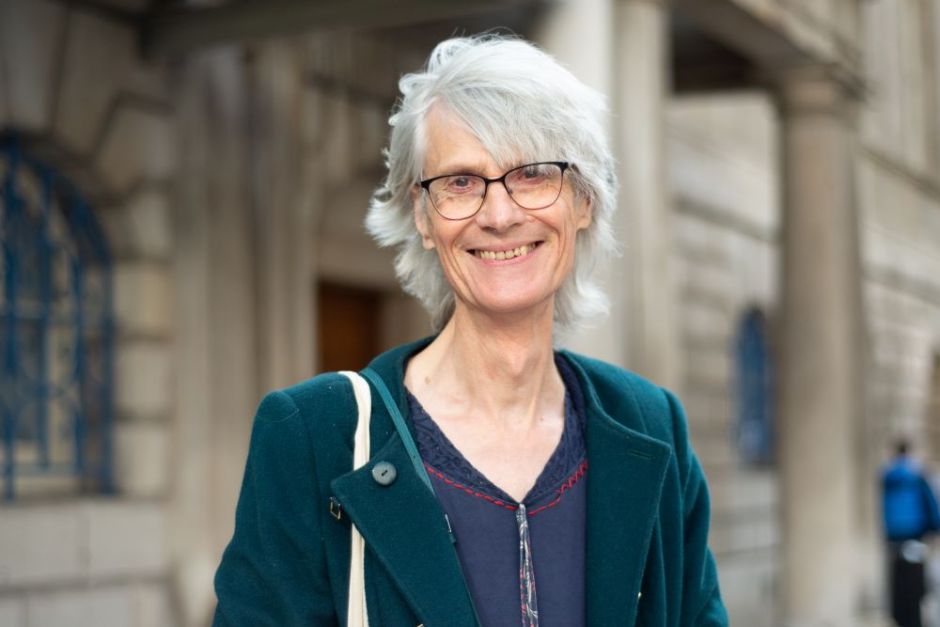
JANE BURN – POETRY AS HARD GRAFT, INSPIRATION, REACTION OR EXPERIMENT?
I interviewed poet & artist Jane Burn who won the Michael Marks Environmental Poet of the Year 2023-24 with A Thousand Miles from the Sea.

I interviewed Linda Newbery, winner of the 2006 Costa Children’s Book Prize with Set In Stone. Before that, Linda was shortlisted for the Carnegie Medal (twice) and the Guardian Children’s Fiction Prize with her novels The Shell House and Sisterland. She has written for young adults, middle-grade and younger readers, as well as adults. Linda is a lifelong campaigner for animal rights.
Leslie: What were the signs in childhood that you were going to be a writer? Who or what encouraged you?
Linda: I loved reading, and read my favourite books over and over again. Some made an indelible impression: Black Beauty (an abridged, illustrated version) is one of the first books I can remember reading by myself. I loved writing stories, too, and decided by the age of 8 that I wanted to be an author. From then on I was usually writing something in secret.
Leslie: Tell us about how your range of novel types and audiences has developed during your career.
Linda: Having started by wanting to be a poet and then a novelist, I settled on young adult fiction for my first few years, while I was still teaching full-time in a comprehensive school. Gradually I wanted to expand, so wrote a few early readers (short, illustrated books for children of about 5+), middle-grade fiction, a picture book and one adult novel (so far). I enjoy the freedom to try different things.

Leslie: Why was your novel that won the Costa Children’s Prize considered ‘controversial’ by some? How do you adapt your style and content to writing ‘crossover’ books?
Linda: Set in Stone, after winning the Costa Prize, was published in an adult edition, and its Romanian and German translations are also on adult lists. It definitely isn’t for young children – I’d say for 14+. It’s difficult for me to explain exactly why without spoilers, but the two main viewpoint characters are both adults and it’s quite a complex plot, so I don’t actually think it would appeal to readers younger than that.
I didn’t particularly think of it as a ‘crossover’ book; it’s the story itself that dictates the style and approach, rather than who I think might read it. It’s a Victorian sensation novel rather in the vein of Wilkie Collins, so the important thing was to use appropriate language and idiom (while differentiating between the two first-person narrators) and to capture the atmosphere I wanted. It turned into the kind of story it needed to be.
Leslie: What for you were the most important takeaways that came out of your collection of essays by children’s authors ‘Writing Children’s Fiction’?
Linda: I think one thing that occurs again and again is to be true to the kind of writer you want to be – though it can be very difficult to balance that against the desire to be published and to sell enough books to go on being published.
Leslie: From your experience, what are the characteristics that make a really good illustrator?
Linda: Interesting question, and I’m not an expert on this. But I’d say that it’s less to do with technical expertise and more to do with engagement and expressiveness, especially with illustrated books for the young. Of course, there are many illustrators who combine both, notable the wonderful Shirley Hughes. There are illustrative styles that don’t appeal to me at all, but we have such a wealth of talent in books for children at the moment. I’m no doubt out of touch, but among those I admire are Pam Smy, Mini Grey, Kate Milner, James Mayhew, Jackie Morris, Katie Rewse, Catherine Rayner and others I’ll think of as soon as I’ve sent these replies.

Leslie: What does writing fiction for adults allow you to do that you wouldn’t do in a children’s book? What are the ground-breaking/experimental/surprising characteristics of children’s writing that don’t often find their way into adult novels?
Linda: There’s less sense of responsibility when writing for adults. For children and teenagers you do need to have that sense, I think; there are some things you just couldn’t do for younger readers – for instance being inside the head of a successful suicide, say, or an anorexic teenager who persisted despite all advice and support. As for the second part of your question: again I’m not a specialist in fantasy fiction, but it strikes me that writers of children’s fiction can be bold and adventurous and expect readers to go along with whatever premise they suggest. For instance, Nicola Davies’ The Song that Sings Us gives a powerful environmental message through a gripping story. I’m wondering if the current trend for ‘verse novels’ started in children’s and young adult fiction? There’s a lot of it about now, for instance Joseph Coelho’s The Girl who Became a Tree, and I remember a striking much earlier example, Make Lemonade by Virginia Euwer Wolff, published on a young adult list in 1993.
Leslie: Why do you often use historical settings in your writing? Which ones attract you, and why?
Linda: I’ve been drawn to the First World War for several novels and stories, and to the Votes for Women campaign, while Set in Stone is set in 1898. With the First World War, I’ve absorbed so much through fiction, poetry, biographies, histories, art, exhibitions and visits to key places on the Western Front that I’ve had enough immersion in the period to feel confident. That period appeals to me because it was such a cataclysm in society, dividing early 20th Century history into before and after the war. It made such a difference to class expectations, undermining social certainties and providing new opportunities for women. In The Shell House I wanted to show this change in tangible form through the mansion itself: an aristocratic home and estate before the war, a burnt-out shell afterwards. I’ve written two short novels about the suffragette campaign, Girls for the Vote and Until We Win, both set in the months leading up to the outbreak of war. That must have been such an exciting time to be a young woman, if you had the chance to participate; and of course the suffragettes and their tactics have inspired many campaigns going on now, for instance Extinction Rebellion and Just Stop Oil – though, for both, civil disobedience is strictly non-violent, unlike some of the more extreme suffragette actions.

Leslie: Tell us why you work for Writers Review and what’s special/different/ characteristic of the publication.
Linda: I started it seven years ago with two writer friends, Adele Geras and Celia Rees – mainly because I enjoy writing reviews and wanted somewhere to put them! Between us we’ve got plenty of author friends and acquaintances, so we knew we could find plenty of contributors, people we already know and others we invite. What I like about our blog is that our guests choose whatever they’d like to review – so as well as new books we cover old favourites and books that people feel have been undervalued. We also include Q&As with authors, special round-ups at Christmas, New Year and our anniversaries, and independent bookshop features. I’m particularly interested in nature writing, animal ethics and sustainability, so several of my own recent choices have been on those subjects.
Leslie: Tell us about your campaigning work and what led you to support these particular campaigns.
Linda: I’ll have to restrain myself here or I’ll write several thousand words! My very first novel for teenagers, Run with the Hare, was about a sixth-form girl who gets involved with animal rights. I’ve always campaigned against animal cruelty, and now support many organisations including Compassion in World Farming, Animal Rising, Open Cages, The Humane League and The League Against Cruel Sports. This Book is Cruelty Free – Animals and Us brings together a lot of the ideas I care about – it’s a compassionate guide to daily life, looking at the decisions we make about what to eat, wear, use, waste and throw away, and how those choices affect animals and the environment.
As well as being an active member of the Green Party, I now work with Plant-Based Councils, helping local campaigners to approach their local authorities and ask for them to commit to plant-based catering to show commitment to their Declarations of Climate Emergency. We’ve already seen several successes, including in Oxfordshire where I live.

Meat-eating remains the elephant in the room – so many people will do their recycling, cut down on flights, switch to electric vehicles, etc., but remain unaware that cutting down on meat and dairy could be the single most effective change they could make to reduce their individual carbon footprint. There’s such reluctance to change. We need council and government leadership on this: animal agriculture, like Big Oil, is destroying the planet, and has powerful forces to sustain it in spite of all evidence that the planet can’t support the wealthier countries of the world eating meat-heavy diets.
My own personal ethical code is that I do all I can to avoid animal suffering. If through my campaigning I can raise awareness and influence others, I see that as productive use of my energy and time.
Next week I interview paper-artist Ellie Clewlow about her innovative work with unwanted books and paper.
ABOUT LESLIE TATE’S BOOKS:

I interviewed poet & artist Jane Burn who won the Michael Marks Environmental Poet of the Year 2023-24 with A Thousand Miles from the Sea.

I interviewed ex-broadcaster and poet Polly Oliver about oral and visual poetry, her compositional methods, and learning the Welsh language. Polly says, “I absolutely love

I interviewed Jo Howell who says about herself: “I’ve been a professional photographic artist since I left Uni in 2009. I am a cyanotype specialist.


Poet Tracey Rhys, writer of Teaching a Bird to Sing and winner of the Poetry Archive’s video competition reviews Ways To Be Equally Human. Tracey,
| Cookie | Duration | Description |
|---|---|---|
| cookielawinfo-checkbox-analytics | 11 months | This cookie is set by GDPR Cookie Consent plugin. The cookie is used to store the user consent for the cookies in the category "Analytics". |
| cookielawinfo-checkbox-functional | 11 months | The cookie is set by GDPR cookie consent to record the user consent for the cookies in the category "Functional". |
| cookielawinfo-checkbox-necessary | 11 months | This cookie is set by GDPR Cookie Consent plugin. The cookies is used to store the user consent for the cookies in the category "Necessary". |
| cookielawinfo-checkbox-others | 11 months | This cookie is set by GDPR Cookie Consent plugin. The cookie is used to store the user consent for the cookies in the category "Other. |
| cookielawinfo-checkbox-performance | 11 months | This cookie is set by GDPR Cookie Consent plugin. The cookie is used to store the user consent for the cookies in the category "Performance". |
| viewed_cookie_policy | 11 months | The cookie is set by the GDPR Cookie Consent plugin and is used to store whether or not user has consented to the use of cookies. It does not store any personal data. |
4 responses
Very interesting, thanks to both of you. I know Linda and have enjoyed 2 of her books, but knew nothing about ‘Set in Stone’. I’m putting it on my list!
Thank you, Jane! 🙂 🙂 🙂
Hi Lesley, this is an inspiring interview. I like the idea of writing a book about animal rights, in particular.
Yes, Linda’s a really fine, versatile writer!